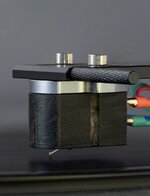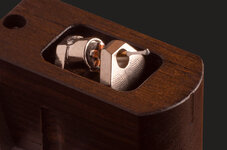Setup
The LS-10 was a breeze to set up on my Technics SL-1210G. I used my trusty decades old MoFi Geo Disc to roughly align the stylus to my preferred Baerwald alignment. Then I used my Vinyl Source arc protractor to get the alignment perfect. SRA was adjusted so that the cartridge body was level to the record. The tracking force was set at the recommended 1.9 grams and an equal amount of anti-skate applied. Phono stage wise, I set my Sutherland Duo at 58 dB gain and loaded the cartridge at 100 ohms. Azimuth (left/right tilt when viewed from the front) was verified with an inexpensive acrylic alignment block- the same thing I used to adjust the arm height/SRA. While I own a Musical Surroundings Fozgometer for adjusting azimuth, I decided to forego its use as I wanted to set up the cartridge the same way any reader could easily do themselves. Most won’t own a $400 device whose sole purpose is to dial in azimuth.
Listening
I used 3 different pairs of speakers during my audition of the LS10 Mk II- the Klipsch Forte IV, Cerwin Vega LA-165 bookshelf /LA-110 subwoofer system and the Audio GE Teddy Classic. The rest of the system was consistent throughout the review. The Klipsch didn’t play well with either my room or my Manley Stingray II integrated amplifier, and don’t account for anything in this review. In fact, they’ve been sold. The Cerwin-Vega system ($670 review forthcoming) was used for most of the listening. Inexpensive, yes, but they sound surprisingly good. The Audio GE Teddy Classics were acquired a couple of weeks ago. Lithuania based Audio GE currently lacks US distribution, but I was able to source a mint preowned pair for a very reasonable price. In Europe, Teddy Classics sell for €3000 a pair.
In many ways, this is the most difficult review I’ve ever written, so let’s get the easy stuff out of the way first. I’ve got a few records that have sibilance issues. Most of them have none with the LS-10 Mk II- they track cleanly. Neither my Grado Reference 3 ($1500) or my Ortofon Quintet Black ($1095) can. Pretty impressive. I say most because the most recent reissue of Grateful Dead’s “Steal Your Face” is still rough. Whether it’s a situation of hot microphones or bad mastering, I can’t say. If the issue is the record itself, no cartridge can fix it. But the other problematic albums in my collection played cleanly. And it’s not due to the setup, as if anything, the other cartridges had a better setup: I used the Fozgometer with those. It also can’t be the Shibata stylus as The Ortofon also sports a Shibata. The improvement with the Le Son isn’t subtle. Which brings up another subject.
While the Le Son LS10 Mk II is priced between the Ortofon and the Grado, it’s not a fair fight. Because both other cartridges are sold through conventional retailers, they have additional mark up that the Le Son offerings lack. Buying factory direct allows one to get more performance for the same money in comparison with cartridges from other manufacturers. I am confident that if the LS-10 Mk II were sold through conventional channels it would be priced somewhere in the $3000 ballpark.
When it comes to cartridges, I value transparency and the ability to make music. All cartridges make sound. Not all cartridges make music- there is a difference. And while all cartridges do something- convert mechanical energy to electrical energy, I want a cartridge that sounds as invisible or transparent as possible. If I get a sense that the cartridge is “doing something” count me out. It’s almost an electromechanical sound that I’m referring to- and any cartridge that exbibits this behavior isn’t a music maker- it just plays records. There are more than a few current offerings that suffer this malady. The LS-10 Mk II is most certainly a music maker.
Why do I have such a hard time describing the sound of the LS-10 Mk II? Because it seems to have no inherent sonic character. It’s not warm like a Grado, nor does it accent the midrange and upper frequencies like some Audio/Technica models do. The Ortofon Quintet Black S has some added vibrancy in the midrange. In comparison the LS-10 Mk II is completely and totally neutral- a truth teller.
Not only does it not add any of its own flavor to the music, it is super quiet in the groove. It is as if the cartridge is levitating above the record and the music is coming through by osmosis. It is totally sonically invisible. As far as a cartridge that sounds as if it is “doing nothing”, it’s a champ.
That said, I couldn’t shake the feeling that I wasn’t getting the complete picture- I kept getting the feeling that I wasn’t getting all the performance that the LS-10 Mk II had to offer. I wondered if setting the Sutherland for a MM cartridge and adding a Step Up Transformer might extract a bit more performance. After looking around at what’s out there and checking my wallet, I scored a pair of vintage 1983 Sony HA-T10 SUTs for $150 shipped from Japan. I didn’t want to spend serious money on a wild guess. Also, some of you may know, I had major emergency surgery last month, so I have some medical bills to cover. Inexpensive vintage was the perfect solution.
And? I was right. And wrong. There is a difference using the SUTs- the gain needed for a low output MC comes with absolutely no noise penalty. Where I was wrong is that I drastically underestimated the improvement that the SUTs brought to my system, and I way underestimated how good the Le Son cartridge is. I now have three categories: cartridges that play records, cartridges that make music and cartridges that make magic. And what I’m hearing now is magical. It’s like in the classic movie “The Wizard of Oz” where the film switches from sepia tones to Technicolor. It’s transformative.
In fact, the presentation was so different that initially I couldn’t figure out what was happening. Everything sounded more real- and much more detailed without being analytical. It’s as if, suddenly, every note was the Most. Important. Note. Ever. Then it dawned on me- listening to record after record I was hearing all kinds of different low-level details that I had never heard before. Just last night I was listening to the Steve Hoffman cut of The Doors’ final album LA Woman. It has a few hits on it, but I got drawn onto one of the other tracks- “Hyacinth House”. Far from a favorite, but last night I was totally mesmerized. I got it, it made sense. And it was beautiful- Jim Morrison’s liquor-soaked voice, the instrumentation- all of it. It’s like hearing it- really hearing it- for the first time. I think tonight will be the non UHQR reissue of Steely Dan’s Aja. I can’t wait to hear what I’ve missed all these years.


